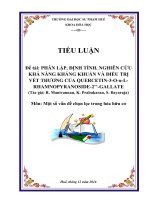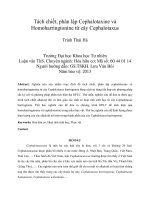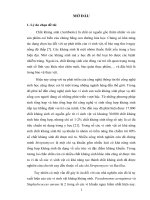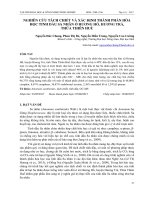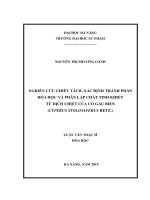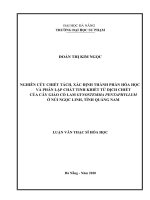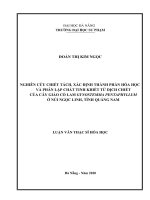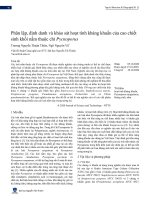AKALOIDS tách chiết phân lập định tính
Bạn đang xem bản rút gọn của tài liệu. Xem và tải ngay bản đầy đủ của tài liệu tại đây (765.51 KB, 22 trang )
AlKALOIDS
1.
INTRODUCTION
2. NAMING OF ALKALOIDS
3. PROPERTIES OF ALKALOIDS
4. CLASSIFICATION OF ALKALOIDS
5. QUALITATIVE TEST FOR ALKALOIDS
6. QUANTITATIVE DETERMINATION OF ALKALOID
7. EXTRACTION METHOD OF ALKALOIDS
8. CONCLUSION
1. INTRODUCE
1. INTRODUCTION
- >25000 compounds
- The term Alkaloid, W. Messner in 1819: for basic nitrogen containing compounds of plant origin.
3. Properties of alkaloids
- New definition, Max Pololopxki: Alkaloid is an organic compound of natural origin:
•
contains a nitrogen atom, is more or less basic
•
is of limited distribution
•
at low doses, marked pharmacological properties
•
Precipitation reaction with common reagents for alkaloids .
1. INTRODUCTION
Forms of Alkaloids:
•
Free bases
•
Salts with organic acids: Oxalic, acetic acids
•
Salts with inorganic acids: HCl, H2SO4
•
Salts with special acids: Meconic acid in Opium, Quinic acid in Cinchona
•
Glycosidal form: Solanine in Solanum
2. NAMING OF ALKALOIDS
• Numerous methods can be used to name alkaloids:
⁺
Generic plant name –atropine from Atropa belladonna.
⁺
Specific name of the plant –cocaine from Erythroxylum coca.
⁺
Common name of the herb –ergotamine from ergot (rye).
⁺
Physiological action of the plant –emetine producingemesis.
⁺
Other: morphine derived from ancient Greek.
⁺
mythology–Morpheus –god of dreams .
3. PROPERTIES OF ALKALOIDS
•
Most alkaloids contain oxygen in their molecular structure.
•
Some alkaloids are colored yellow, orange, or colorless.
•
Most alkaloids are weak bases.
•
Many alkaloids dissolve poorly in water but readily dissolve
in organic solvents.
•
Most alkaloids have a bitter taste or are poisonous when ingested .
4. CLASSIFICATION OF ALKALOIDS
1.
Biological origin
There are 4 main groups: Sedatives, Vasodilatation, Local
anesthetic, Hallucinating
For example: Morphine, cocaine….
3. Properties of alkaloids
3. Chemical classification
•
•
•
•
True (Typical) alkaloids
Proto alkaloids
Pseudo alkaloids
False alkaloids
2. Biosynthetic pathway
•
•
•
•
•
Ornithine- Tropane, Pyrrolidine, Pyrrolizidine
Tyrosine-Benzyl isoquinoline
Tryptophane- Indole alkaloids, Quinoline
Pyridine, Nicoticnic acid- Pyridine
Lysine- Quinolizidine, Piperidine
Cocaine
Caffeine
Ephedrine
BELLADONA
Atropa belladonna, Solanaceae
Use part: folium
Chemical composition:
• Alkaloid content 0.3-0.6%.
• Hyoscyamine as chief constituent (90%), occures alongside
scopolamine (2%) and their dehydration products (7%).
• Small quantity of scopoletol (a coumarine).
COCA
Erythroxylum coca, Erythroxylaceae
Constituents
• Variable quantitesof an essential oil including
methylsalicilate, flavonoids, tannins.
• Alkaloids (0.5-1.5 %): Cocaine (=methylbenzoylecgonine,
30-50%), cinnamylcocaine (=methylcinnamylecgonine),
truxillines (esters of a dicinnamicacid), several pyrrolidines
(hygrine, cuscohygrine).
cinnamylcocaine
hygrine
Datura metel, Solanaceae
Chemical composition
• Minerals (18-20 %).
• Total alkaloid content: 0.04-0.15%.
• Hyoscyamine is the chief constituent and the percentage of
scopolamine can be high (25 % and more).
Uses
• Hebane is not used much more than stramonium.
• It is an ingredient of combinations, for example with buckthorn,
aloe (stimulant laxative), belladonna (gastrointestinal pain), or ephedrine (asthma).
5. QUALITATIVE TEST FOR ALKALOIDS
1. Mayer’s reagents
•
Mayer’s reagent is an alkaloid precipitating reagent used for the detection of alkaloids
in natural products. Most alkaloids are precipitated from neutral or slightly acidic
solution by Mayer’s reagent (potassium mercuric iodide solution) to give a white or
yellow color precipitate.
Figure 1. Proposed reaction
of Mayer test
HgCl2 + 2KI
HgI2 + KCl
HgI2 + 2KI
K2[HgI4]
Potassium-Alkaloid
precipitate (yellow)
5. QUALITATIVE TEST FOR ALKALOIDS
2. Wagner’ s reagent
•
The positive results of alkaloid test in Wagner test was confirmed by the presence of
brownish to reddish-brown precipitate. The precipitate was predicted as the presence of
potassium-alkaloid
•
In Wagner reagent preparation, iodine reacts with I- ion from potassium iodide
producing I3- ion (brownish solution)
potassium-alkaloid
5. QUALITATIVE TEST FOR ALKALOIDS
3. Dragendorff’s reagent
•
Dragendorff’s test reagent is a colour reagent that can be used to identify alkaloids in test samples or as a chromatography plate stain. Alkaloids will
react with Dragendorff’s test reagent and form an orange or orange-red precipitate if they are present in the sample solution.
BiI3 + 3KNO3
Bi(NO3)3 + 3KI
3+
Bi + H2O
BiI3 + KI
Brown
+
+
BiO + 2H
K[BiI4]
+
+
K[BiI4]
Potassium-Alkaloid
precipitate
[BiI4]
Orange
5. QUALITATIVE TEST FOR ALKALOIDS
4. Hager’s reagent
•
Hager's test was done by adding a few drops of the reagent to plant extracts and appeared a yellow-colored precipitate that indicates the presence of
alkaloids. Hager's reagent is saturated solution of picric acid
5. Tannic acid solution ( 5% w/v): Gives buff colored ppt which is soluble in dil.acid or ammonia
6. Ammonium reineckate solution: 2% solution, produces precipitates with heterocyclic nitrogen alkaloids, with quaternary some tertiary amine
6. QUANTITATIVE DETERMINATION OF ALKALOID
Volumetric methods:
These are base on reaction of alkaloidal bases the with acids ( acid – base titration)
They include:
Aqueous titration: this is carried by either:
1. Direct titration of the alcoholic solution of the alkaloidal residue with standard acid, or
2. Back titration by dissolving the resdue in a know amount of standard acid and back titration of residual acid against standard alkali
Non- aqueous titration: this method is suitable for determination of weak bases e.g. Caffeine
6. QUANTITATIVE DETERMINATION OF ALKALOID
Gravimetric methods:
They can be performed by either:
1. Direct weighing of the alkaloidal mixtures
2. Precipitation of the total alkaloids and determination of the weight of the precipitate obtain
Spectrophotometric method (Spectrophotometric method foe estimation of alkaloids perceptible with Dragendorff’s reagent in plant materials)
Fluorimetric method. ( Simplified fluorimetric determination of digitalis alkaloids Datt V. Naik)
Polarimetric method. ( the colorimetric determination of various alkaloid Authors F. J. Bandelin)
7. EXTRACTION METHOD OF ALKALOIDS
The extraction of alkaloids is based on their basic character and solubility pattern:
•
The fact that alkaloids normally occur in the plant as salts
•
Solubility of various salts and bases in water and organic solvents
•
Plant materials often contain significant amounts of fats that, in addition to
extraction, by forming emulsions. So the fat is reduced by petroleum ether.
tannins, proteins, resins and colorants, can interfere with
STASS-OTTO METHOD
3. Properties of alkaloids
MANSKE’S METHOD
3. Properties of alkaloids
8. CONCLUSION
Alkaloids are very important compounds for human beings. For ages their extracts
were used as a cure to rescue people from pain like morphine and some illnesses
like quinine in malaria and colchicine in gout. Thanks to alkaloids during ages,
people can cure the diseases and improve their life.
Thank you for listening!

